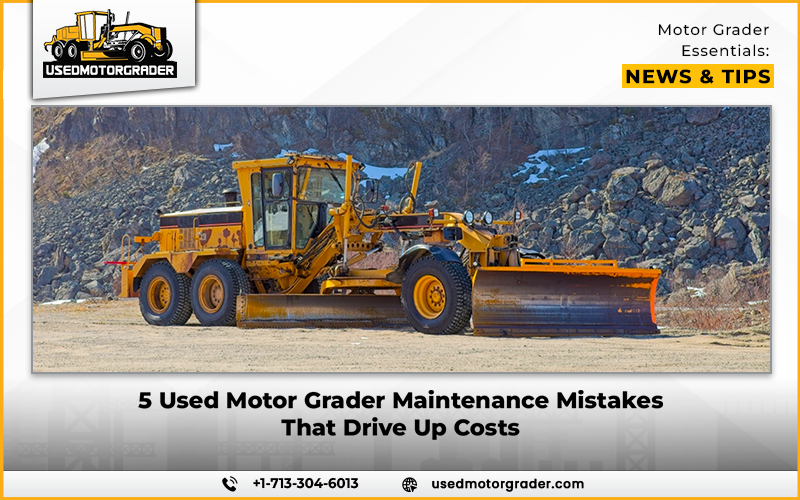Purchasing a used motor grader is an intelligent decision for contractors seeking dependable operation without incurring new-equipment costs.
Yet owning a grader is not just about completing the job; it’s about maintaining operating expenses at affordable levels.
Most machine owners make simple maintenance errors unknowingly that can decrease machine life, depreciation value, and cause repair bills to skyrocket.
Steering clear of these mistakes can be the difference between your grader’s success and your profitability. Below, we dissect five key maintenance blunders that drive up operating costs and how you can avoid them.
Ignoring Routine Inspections
Ignoring routine walkarounds and system checks is a common and expensive mistake with any used motor grader.
Daily inspections may not seem like much, but they are frequently the first chance to find wear, leaks, or loose parts early on.
In addition to requiring costly repairs, waiting until something breaks down can cause project delays and reduce productivity on the job site.
For instance, early detection of a slow hydraulic leak can shield future seals or the hydraulic pump from harm. Ignoring these easy checks can quickly lead to a complete failure. Make it a habit to inspect it every day.
Hours of downtime later on, costing thousands of dollars, can be avoided with just ten minutes at the beginning of the day.
Running with Contaminated Fluids
Your motor grader’s coolant, transmission oil, hydraulic fluid, and engine oil are its vital components. However, a lot of operators still use outdated or tainted fluids, which impair performance.
In addition to decreasing cooling effectiveness and increasing wear and friction, dirty fluids can even damage important parts.
With a used motor grader, where prior ownership may not have included regular fluid changes, it’s especially crucial.
The machine’s systems are already under more stress if it is used in harsh or dusty conditions.
The standard practice is to adhere to OEM fluid change intervals. Adapt your schedule to the grader’s usage and location for the best care.
Neglecting the Blade and Cutting Edges
Most contractors pay attention to the engine and hydraulics, but not the work tool of the grader, the blade.
Inconsistent or blunt cutting edges cause the whole machine to work harder, consume more fuel, and affect grading accuracy.
Even worse, they may wear out the moldboard too much or even stress the frame in the long run.
Replacing worn cutting edges partway through their life span might appear to be an unnecessary expense- but it is a wise one.
It encloses the core parts of the grader and ensures the coating is as smooth as your clients are used to.
On any used motor grader, you will want to check the blade condition frequently and look for areas where it is wearing inconsistently, which may indicate either poor alignment or use.
Overview of Electrical Systems and Sensors
The more sophisticated the graders are, the more advanced they are in their electrical systems. Sensors, digital gauges, GPS controls, and telematics are common in modern machines, particularly in new model used motor grader models.
People rely on them for efficiency, yet often overlook them during regular checks.
An example is that a faulty slope sensor could cause expensive rework. You can avoid costly and frustrating downtime by frequently checking the machine’s electrical system, including the battery condition and harness connections.
Skipping Undercarriage Cleaning and Maintenance
On any work site, the grader’s undercarriage is subjected to a beating. Mud and gravel accumulate around moving parts, out of sight and out of mind.
If you neglect that buildup, it traps moisture, wears down pins and bushings, and corrodes the key frame components.
Washing the undercarriage and checking it after every few shifts might not seem important, but it’s worth it in terms of lifespan.
This becomes especially important when you’re working with a used motor grader that has already seen years of service.
Good maintenance prolongs the machine’s useful life and makes it function like brand new even in tough conditions.
A Smarter Approach to Ownership
Used motor graders offer outstanding value, but you must handle them with care and a clear maintenance plan.
Very frequently, proprietors commit preventable errors, which raise expenses and reduce equipment life.
The key is to stay proactive: inspect the machine regularly, fix worn parts before they fail, and always stay alert instead of relying on autopilot.
If you’ve recently bought a used motor grader or are reviewing your company’s maintenance procedures, ask yourself these 5 questions to avoid unnecessary spending.
More to the point, it maintains your operations running smoothly as well as your margins healthy.


